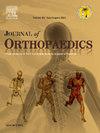Finite element analysis of Scarf osteotomy for precise treatment of hallux valgus
IF 1.5
Q3 ORTHOPEDICS
引用次数: 0
Abstract
Background
The treatment of hallux valgus is currently in face of many challenges in clinical practice. Although conventional surgical procedures can correct deformities to a certain extent, some key parameters such as osteotomy displacement and angle are often difficult to determine, leading to increased uncertainty in surgical outcomes and a relatively high incidence of postoperative complications.
Objective
Hallux valgus is a common foot deformity that often leads to pain, difficulty in walking, and other health problems, seriously affecting the quality of life of patients. In order to provide patients with more precise treatment, we aimed to simulate the Scarf osteotomy for the treatment of hallux valgus using the finite element method, and comparatively analyze the mechanical performance indicators under different distal osteotomy displacements. We hoped to provide scientific and reasonable treatment plans for clinical practice and better treatment outcomes for patients.
Methods
A volunteer with moderate hallux valgus was selected as the research subject in this study. Preoperative plantar pressure test was conducted, and the CT data of the patient's affected foot was collected to create the finite element model using finite element software. After verifying the validity of the model, it was used to simulate the translational Scarf osteotomy under different settings. Specifically, the distal end of the bone fragment was pushed outwards by varying distances (2 mm, 4 mm, 6 mm, and 8 mm) and was fixed with screws. The maximum Von Mises stresses on the first to fifth metatarsal bones, the sole and the heel under four different surgical settings were compared with the preoperative values, and the changes in the maximum Von Mises stress on the screws were examined.
Results
When the distal end of the bone fragment was pushed outwards by 6 mm, the maximum Von mises stress on the first metatarsal bone (9.4711 MPa) reached its highest value, while the maximum Von mises stresses on the second and third metatarsal bones (0.34062 MPa and 1.6246 MPa, respectively) and on the screws (40.99 MPa) were at the lowest values. The maximum plantar pressure detected during static test was 0.292 MPa, while the maximum plantar stress observed in the finite element model was 0.25733 MPa, indicating comparable values between the two.
Conclusions
Based on precise and customized preoperative design and finite element analysis, it was found that the Scarf osteotomy with the distal end of the bone fragment pushed outwards for 6 mm could yield the best treatment effect for hallux valgus. Under this setting, the stress on the first metatarsal bone was the highest, while the stresses on the second and third metatarsal bones were the lowest, suggesting that it can relieve the stress on lateral metatarsal bones and improve the stress distribution of the forefoot. Overall, Scarf osteotomy under 6 mm setting can effectively correct hallux valgus deformity, reduce the incidence of metastatic plantar pain and prevent the recurrence of metastatic plantar pain after surgery. By improving the patient's plantar stress distribution, this surgical setting is expected to provide better clinical outcomes.
丝巾截骨术精确治疗拇外翻的有限元分析
背景目前拇外翻的治疗在临床实践中面临诸多挑战。常规手术虽然能在一定程度上矫正畸形,但截骨位移、角度等关键参数往往难以确定,导致手术结果的不确定性增加,术后并发症发生率较高。目的拇外翻是一种常见的足部畸形,常导致疼痛、行走困难等健康问题,严重影响患者的生活质量。为了给患者提供更精准的治疗,我们拟采用有限元法模拟Scarf截骨术治疗拇外翻,对比分析不同远端截骨位移下的力学性能指标。希望为临床实践提供科学合理的治疗方案,为患者提供更好的治疗效果。方法选择1例中度拇外翻志愿者作为研究对象。术前进行足底压力测试,收集患者患足CT数据,利用有限元软件建立有限元模型。在验证了模型的有效性后,将其用于模拟不同设置下的平移式Scarf截骨术。具体来说,将骨碎片远端向外推不同距离(2mm、4mm、6mm和8mm),并用螺钉固定。比较4种不同术式下第一~第五跖骨、足底和足跟的最大Von Mises应力与术前值,并观察螺钉上最大Von Mises应力的变化。结果当骨碎片远端向外推进6 mm时,第一跖骨最大Von mises应力(9.4711 MPa)最大,第二、第三跖骨最大Von mises应力(0.34062 MPa、1.6246 MPa)最小,螺钉最大Von mises应力(40.99 MPa)最小。静力试验测得的最大足底压力为0.292 MPa,有限元模型测得的最大足底应力为0.25733 MPa,两者具有可比性。结论通过精确定制的术前设计和有限元分析,发现骨片远端外翻6mm的Scarf截骨术治疗拇外翻效果最佳。在此设置下,第一跖骨的应力最大,第二和第三跖骨的应力最小,说明可以缓解外侧跖骨的应力,改善前足的应力分布。综上所述,6mm设置下的Scarf截骨术可以有效矫正拇外翻畸形,减少转移性足底疼痛的发生率,防止术后转移性足底疼痛的复发。通过改善患者的足底应力分布,这种手术环境有望提供更好的临床结果。
本文章由计算机程序翻译,如有差异,请以英文原文为准。
求助全文
约1分钟内获得全文
求助全文
来源期刊

Journal of orthopaedics
ORTHOPEDICS-
CiteScore
3.50
自引率
6.70%
发文量
202
审稿时长
56 days
期刊介绍:
Journal of Orthopaedics aims to be a leading journal in orthopaedics and contribute towards the improvement of quality of orthopedic health care. The journal publishes original research work and review articles related to different aspects of orthopaedics including Arthroplasty, Arthroscopy, Sports Medicine, Trauma, Spine and Spinal deformities, Pediatric orthopaedics, limb reconstruction procedures, hand surgery, and orthopaedic oncology. It also publishes articles on continuing education, health-related information, case reports and letters to the editor. It is requested to note that the journal has an international readership and all submissions should be aimed at specifying something about the setting in which the work was conducted. Authors must also provide any specific reasons for the research and also provide an elaborate description of the results.
 求助内容:
求助内容: 应助结果提醒方式:
应助结果提醒方式:


